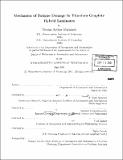Mechanics of fatigue damage in titanium-graphite hybrid laminates
Author(s)
Burianek, Dennis Arthur
DownloadFull printable version (14.34Mb)
Other Contributors
Massachusetts Institute of Technology. Dept. of Aeronautics and Astronautics.
Advisor
S. Mark Spearing.
Terms of use
Metadata
Show full item recordAbstract
Titanium-graphite hybrid laminates are being developed for high-temperature aerospace applications. Experimental observations have indicated that cracks in the titanium facesheets initiate at free edges as well as in areas of high stress concentration, such as holes and notches and that a delaminated region between the facesheet and the intact plies develops and propagates in the wake of the facesheet crack. This thesis experimentally and analytically evaluates the facesheet crack and delamination growth behavior of TiGr laminates. The delamination growth behavior is studied by isolating delamination growth using TiGr specimens with facesheet seams. The growth rate of delamination from facesheet seams is related via a power law to the applied strain energy release rate. It is shown that elevated temperatures significantly increase the growth rate of facesheet delamination. The facesheet crack growth behavior in TiGr laminates was measured experimentally and compared to model predictions. It is shown that the crack growth rate in TiGr facesheets is significantly lower for TiGr laminates as compared to monolithic titanium. After an initial decrease in crack growth rate, the crack propagates at a constant rate while the crack growth rate for monolithic titanium increases as the crack extends. (cont.) A three-dimensional finite element model was implemented that captured the experimental crack growth trends without any additional tuning parameters. A global, bridged-crack model was not accurate in predicting the facesheet crack growth behavior of TiGr laminates. The bridged-crack model failed because it did not capture the details of the bridging stresses and delamination in the vicinity of the crack tip. In contrast to the delamination growth from facesheet seams, it was shown that elevated temperatures did not significantly affect the growth rate of the titanium facesheet crack. Future efforts to model composite damage growth using global modeling approach must validate the model to ensure that all of the necessary parameters are captured.
Description
Thesis (Ph. D.)--Massachusetts Institute of Technology, Dept. of Aeronautics and Astronautics, 2001. Includes bibliographical references (p. 195-207).
Date issued
2001Department
Massachusetts Institute of Technology. Department of Aeronautics and AstronauticsPublisher
Massachusetts Institute of Technology
Keywords
Aeronautics and Astronautics.